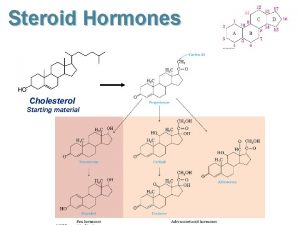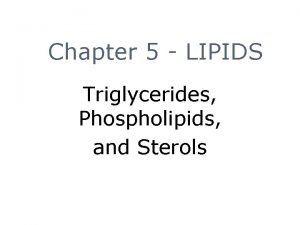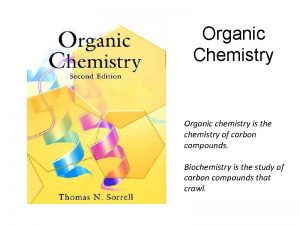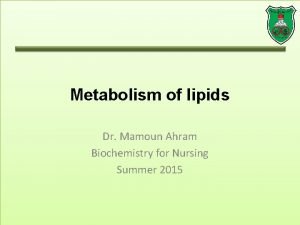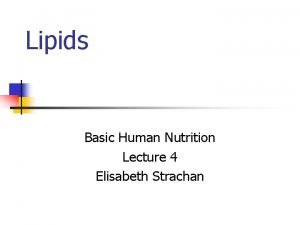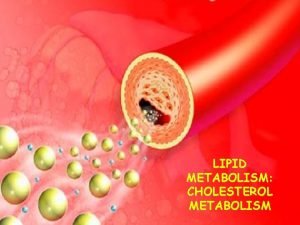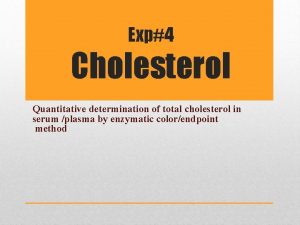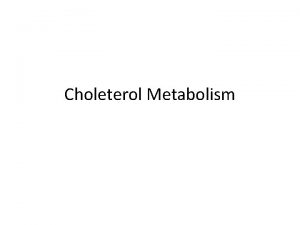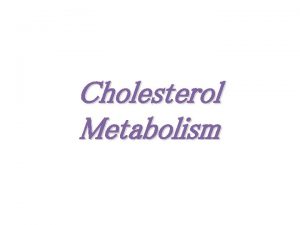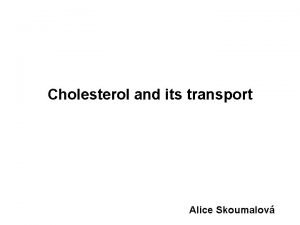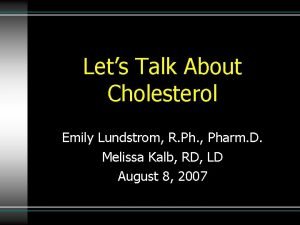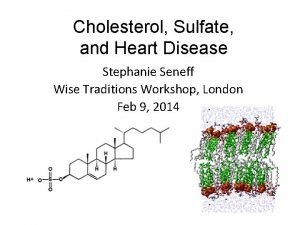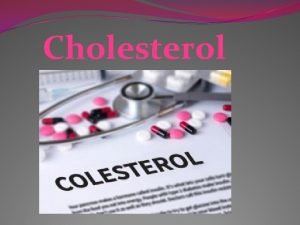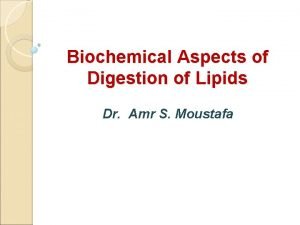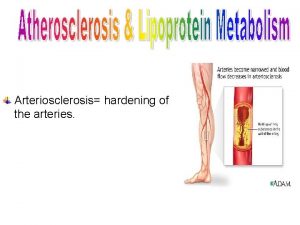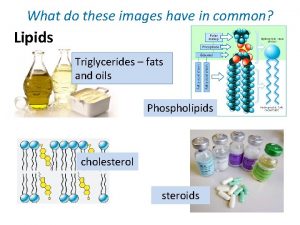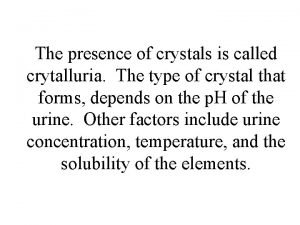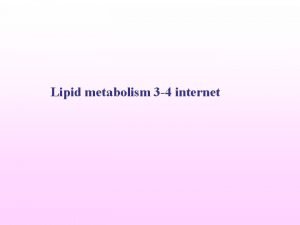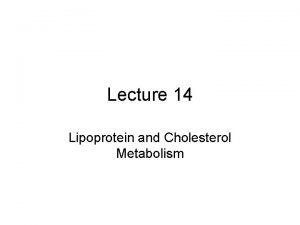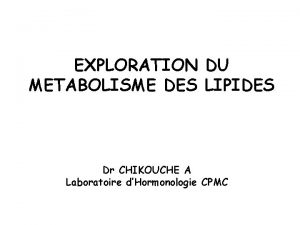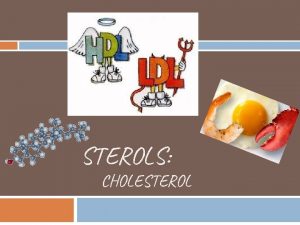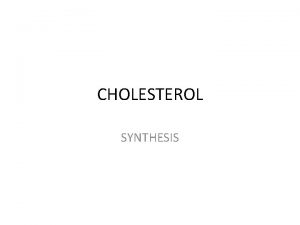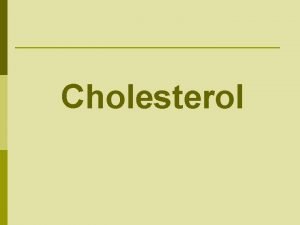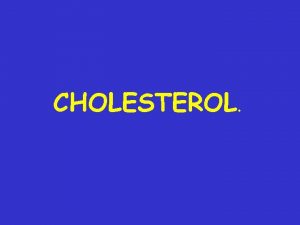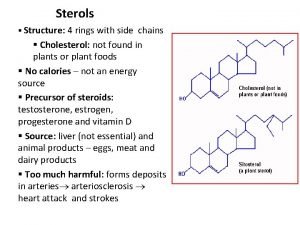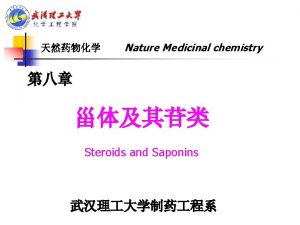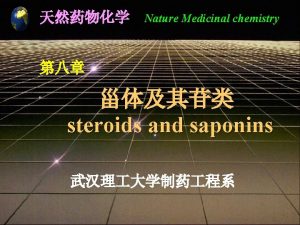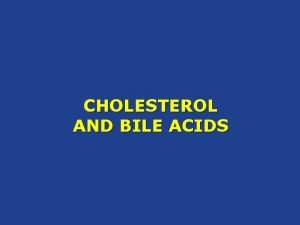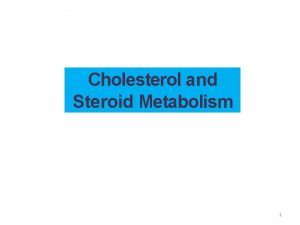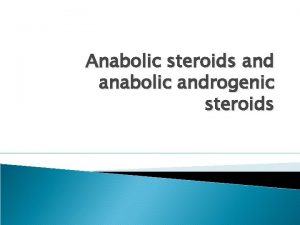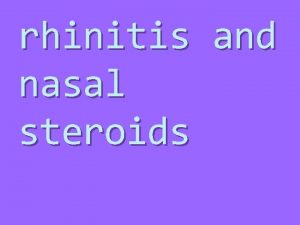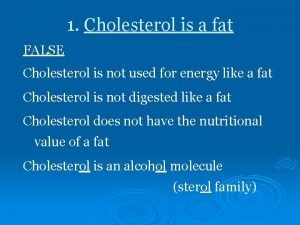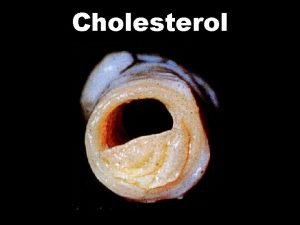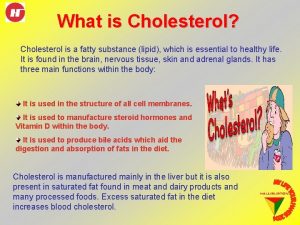CHOLESTEROL AND STEROIDS Sterols steroids are class of























- Slides: 23

CHOLESTEROL AND STEROIDS


• Sterols (steroids) are class of lipids that are derivatives of a tetracyclic hydrocarbon

Steroids • Steroids are lipids containing a steroid nucleus (core structure) • The steroid nucleus is a fused ring system consisting of three cyclohexane rings and one cyclopentane ring • The rings are designated A, B, C and D • Attachment of different groups to the core steroid structure leads to a wide variety of steroid compounds, including cholesterol, bile salts and steroid hormones

Cholesterol • Cholesterol is the most abundant steroid in animals - plants have very small amounts (but have related compounds) - it’s a major component of cell membranes, and affects the fluidity of the membrane due to its bulky structure - is a precursor for biosynthesis of many other steroids • Cholesterol is called a sterol because it contains an alcohol group • We can obtain cholesterol from our diet (animal products), but our liver can also synthesize all the cholesterol that we need - the liver synthesizes more cholesterol when dietary intake is low - excessive blood cholesterol is associated with atherosclerosis and formation of gallstones

History 1855 – Addison’s disease 1856 – Adrenal glands essential for life 1930 – Cortex > medulla 1932 – Cushing’s syndrome 1949 – Hench et al (Steroids in rheumatoid arthritis) 1952 – Aldosterone

Steroid Hormones • Hormones act as chemical messengers • They are important in control of many biological functions • They are secreted from endocrine glands (and placenta) • They react with receptors on cell surfaces to trigger a cascade response • Usually control metabolism at the gene level • Steroid hormones are biosynthesized from cholesterol

Adrenal Corticosteroids • Adrenal corticosteroids are hormones produced in the adrenal glands (located just above the kidneys) • Cortisone (a glucocorticoid) raises the blood glucose level by causing tissues other than the brain to switch to metabolizing fats and proteins; it also suppresses the immune response and can be used as an anti-inflammatory anti-allergy medication • Aldosterone (a mineralcorticoid) regulates ion balance by promoting re-absorbtion of Na+, Cl- and HCO 3 - by the kidneys • Prednisone is a synthetic corticoid used to treat various inflammatory conditions, such as asthma and rheumatoid arthritis

CHOLESTEROL IS THE BIOSYNTHETIC SOURCE OF ALL STEROID HORMONES • Five major classes of hormones – Progestins (regulate events during pregnancy and are precursors to all other steroid hormones) – Androgens (male sexual characteristic development and maintenance) – Estrogens (female sexual characteristics development and maintenance) – Glucocorticoids (promote gluconeogenesis, and in certain doses suppress inflammation rxns) – Mineralocorticoids (regulate ion balance in kidney)


Glucocorticoids (e. g. , prednisolone) used to suppress inflammation, allergy and immune responses. Anti-inflammatory therapy is used in many illnesses (e. g. , Rheumatoid Arthritis, Ulcerative Colitis, Bronchial Asthma, eye and skin inflammations).

Triamcinolone: used for severe asthma and for local joint inflammation (intra-articular inj. ).

Beclometasone, diproprionate, budesonide: used in asthma, (aerosol).

BILE ACIDS ARE CHOLESTEROL DERIVATIVES • Emulsify dietary lipids • Secreted from liver, stored in gall bladder, passed through bile duct into intestine • Bile acids represent a major metabolic fate of cholesterol, accounting for more than half of the 800 mg/day of cholesterol metabolized (steroid hormones represent about 50 mg of cholesterol per day) • Bile acids are recycled through small intestine

Bile Salts • Bile salts are synthesized from cholesterol in the liver - they are stored in the gall bladder and released into the upper small intestine to help break down fats and oils (like soaps) - too much accumulated cholesterol in the gall bladder can lead to gallstones; if a gallstone passes into the bile duct, severe pain results and the gallbladder often has to be removed

FATE OF CHOLESTEROL • Cholesterol is used by cells to decrease fluidity of cell membrane • Used in steroid hormone biosynthesis • Used in Vit A D E K biosynthesis • Cholesterol can also be exported from liver as bile acids, cholesteryl esters, or biliary cholesterol – Cholesteryl esters are transported to other tissues to use cholesterol

Androgens • - male sex hormones – synthesized in the testes – responsible for the development of male secondary sex characteristics


Negative Health Effects Acne Irritability and aggression (ROID RAGE) Elevated cholesterol levels Adolescent use may cause a premature stop in lengthening bones (Stunted growth) • Mood swings (extremes) • •

Negative Effects, cont. • Injecting users subject themselves to Hepatitis or HIV. • Withdrawal symptoms when one stops using steroids: mood swings, fatigue, restlessness, loss of appetite, insomnia, reduced sex drive, and depression. • Depression can lead to suicide. • If untreated, the withdrawal symptoms could last up to a year after stopping the use.



 Steroids and cholesterol
Steroids and cholesterol Cholesterol steroids
Cholesterol steroids Triglycerides phospholipids and sterols
Triglycerides phospholipids and sterols Antigentest åre
Antigentest åre Sex and cholesterol
Sex and cholesterol Good and bad cholesterol
Good and bad cholesterol Good and bad cholesterol
Good and bad cholesterol Non polar molecules that include fats oils and cholesterol
Non polar molecules that include fats oils and cholesterol Cholesterol precursor
Cholesterol precursor How to determine total cholesterol
How to determine total cholesterol How is cholesterol made
How is cholesterol made Biological significance of cholesterol
Biological significance of cholesterol Lipoproteins
Lipoproteins Do we need cholesterol
Do we need cholesterol Cholesterol treatment trialists collaboration
Cholesterol treatment trialists collaboration Stephanie seneff cholesterol
Stephanie seneff cholesterol Function of cholesterol
Function of cholesterol Lipid digestion enzymes
Lipid digestion enzymes Lovastatin side effects
Lovastatin side effects What do these images have in common
What do these images have in common Thorn apple crystals in urine
Thorn apple crystals in urine Is cholesterol a lipid
Is cholesterol a lipid Cholesterol esterification
Cholesterol esterification Aspect du serum clair
Aspect du serum clair
